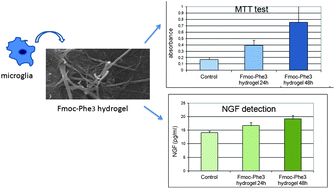Self-assembling peptide hydrogels promote microglial cells proliferation and NGF production
Abstract
Peptidic hydrogels are an interesting class of materials, with potential applications in tissue engineering and controlled

* Corresponding authors
a
Department of Chemistry, Sapienza University of Rome, Piazzale Aldo Moro 5, 00185 Rome, Italy
E-mail:
cleofe.palocci@uniroma1.it
Fax: +39 06490324
Tel: +39 0649913317
b Department of Physiology and Pharmacology “Vittorio Ersparmer”, Sapienza University of Rome, Piazzale Aldo Moro 5, 00185 Rome, Italy
c Institute of Molecular Biology and Pathology, CNR National Research Council, c/o Department of Biology and Biotechnologies, Sapienza University of Rome, Via degli Apuli 4, Rome, Italy
Peptidic hydrogels are an interesting class of materials, with potential applications in tissue engineering and controlled

 Please wait while we load your content...
Something went wrong. Try again?
Please wait while we load your content...
Something went wrong. Try again?
L. Chronopoulou, A. R. Togna, G. Guarguaglini, G. Masci, F. Giammaruco, G. I. Togna and C. Palocci, Soft Matter, 2012, 8, 5784 DOI: 10.1039/C2SM25528F
To request permission to reproduce material from this article, please go to the Copyright Clearance Center request page.
If you are an author contributing to an RSC publication, you do not need to request permission provided correct acknowledgement is given.
If you are the author of this article, you do not need to request permission to reproduce figures and diagrams provided correct acknowledgement is given. If you want to reproduce the whole article in a third-party publication (excluding your thesis/dissertation for which permission is not required) please go to the Copyright Clearance Center request page.
Read more about how to correctly acknowledge RSC content.
 Fetching data from CrossRef.
Fetching data from CrossRef.
This may take some time to load.
Loading related content
